As an Amazon Associate KitchenwareSets.com earns from qualifying purchases.
13 Inspiring Kitchen Backsplash Ideas for Brown Cabinets
Are your brown cabinets making your kitchen feel a bit… stuck in the past? You’re not alone. Many homeowners love the warmth and richness of wood, but worry it makes their space feel dark or dated, especially compared to the all-white kitchens that have dominated design trends.
You might be looking at your perfectly good cabinets, thinking a full, costly renovation is the only way to modernize your space. But what if the secret to a complete kitchen transformation isn’t about replacing the cabinets at all, but about what you pair them with? The right backsplash can act as a bridge, connecting your classic cabinets to a fresh, contemporary style.
The best backsplash for brown cabinets balances color, material, and pattern to either complement the wood’s warmth or create a striking, modern contrast. As a design strategist, I’ve seen countless kitchens revitalized not by a full renovation, but by a single, impactful backsplash update. This guide distills those successful transformations into actionable ideas for your home, proving that your brown cabinets are the perfect foundation for a stunning, stylish kitchen.
Understanding the Golden Triangle: Cabinets, Countertops, and Backsplash
To choose a backsplash, you must first decide if you want to create a look of contrast or harmony. The “Golden Triangle” of kitchen design refers to the visual relationship between your cabinets (the main vertical element), your countertops (the main horizontal element), and your backsplash, which ties them both together. Understanding this helps you create a cohesive and balanced design.
- Creating Contrast: This is about making elements stand out. If you have dark brown cabinets, a light backsplash like white or cream will pop, making the kitchen feel brighter and more open. Conversely, a dramatic black backsplash can create a sophisticated, moody look.
- Creating Harmony: This approach focuses on a more seamless, blended aesthetic. For this, you would choose a backsplash in a color that shares similar undertones with your wood cabinets. Think warm beiges, taupes, earthy terracotta, or soft, warm grays. The goal is to create a calm, cohesive flow.
- The Countertop’s Role: Your countertop is the bridge. A light countertop (like white quartz) is incredibly versatile and allows you to go either light or dark with your backsplash. If you have a busy granite countertop, a simpler, single-color backsplash is usually best to avoid visual clutter.
13 Inspiring Kitchen Backsplash Ideas to Elevate Your Brown Cabinets
Ready for a transformation? This curated list of 13 backsplash ideas is packed with a mix of timeless classics and the freshest trends for 2025. Whether your style is modern farmhouse, sleek contemporary, or rustic industrial, you’ll find the perfect inspiration here. Each idea includes practical tips and a visual prompt to help you picture the look in your own home.
https://www.pinterest.com/pin/24-stylish-backsplash-ideas-for-brown-cabinets-and-black-countertops–936889528717412827/
1. The Timeless Classic: Bright White Subway Tile
A bright white subway tile backsplash is a can’t-go-wrong choice that instantly brightens a kitchen with brown cabinets and provides a clean, timeless backdrop. It’s versatile enough for any style, from farmhouse to modern.
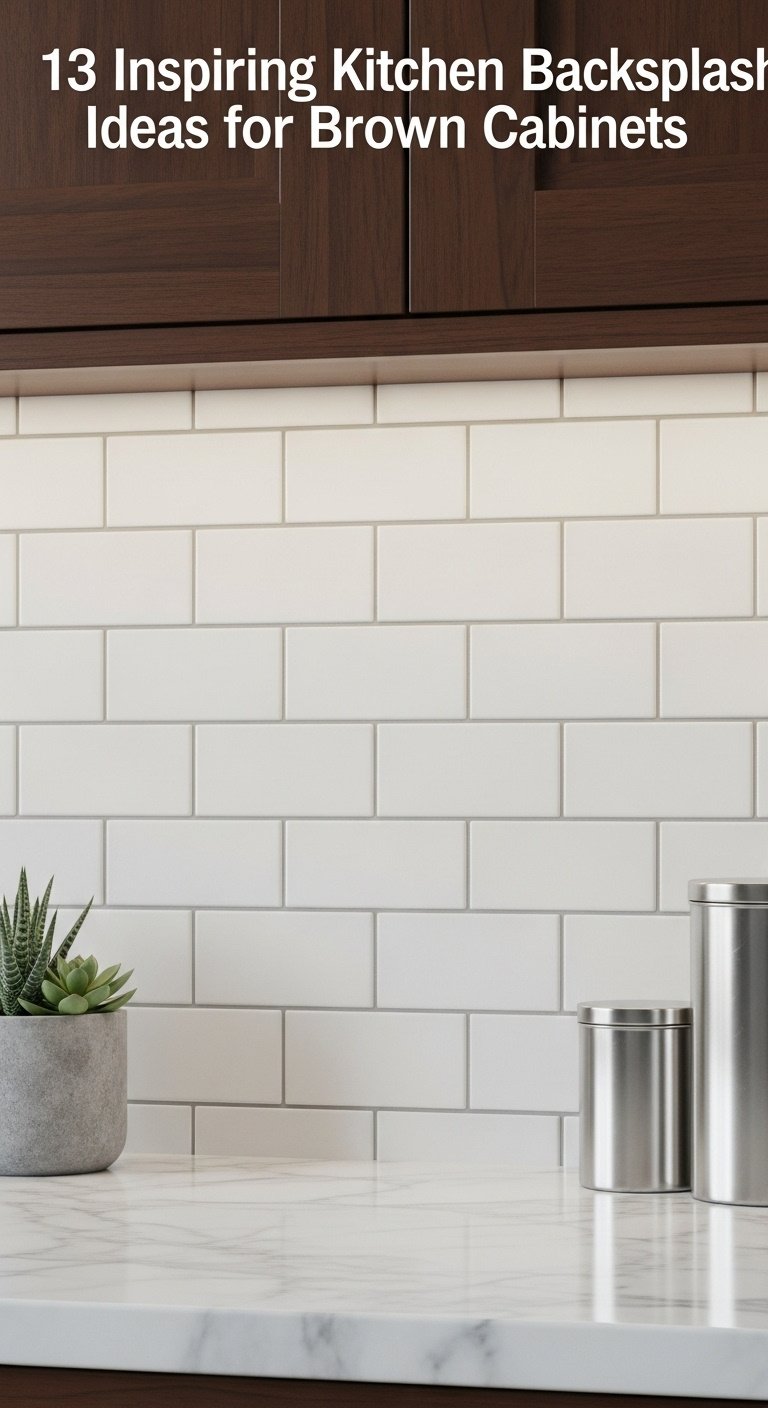
- Materials Needed: 3×6 inch white subway tiles, thin-set mortar, notched trowel, tile spacers, wet tile saw, grout, grout float, sponge.
- Step-by-Step Directions:
- Clean and prep the wall surface, ensuring it’s smooth and dry.
- Mix the thin-set mortar according to package directions.
- Apply mortar to a small section of the wall with the notched trowel.
- Press tiles into the mortar in an offset pattern, using spacers to maintain even grout lines.
- Use the wet saw to make precise cuts for tiles around edges and outlets.
- Allow the mortar to cure for 24 hours, then remove spacers and apply grout with the grout float.
- Wipe away excess grout with a damp sponge, rinsing it frequently.
Pro-Tip: For a modern twist on this classic, consider a contrasting grout color like charcoal or black. This makes the pattern pop and adds a graphic element that pairs well with modern hardware.
Pin this timeless look to your ‘Dream Kitchen’ board!
2. Modern Drama: The Sleek Black Slab Backsplash
A sleek black slab backsplash creates an incredibly dramatic and luxurious statement, offering a seamless and sophisticated look that contrasts beautifully with the warmth of brown cabinets.
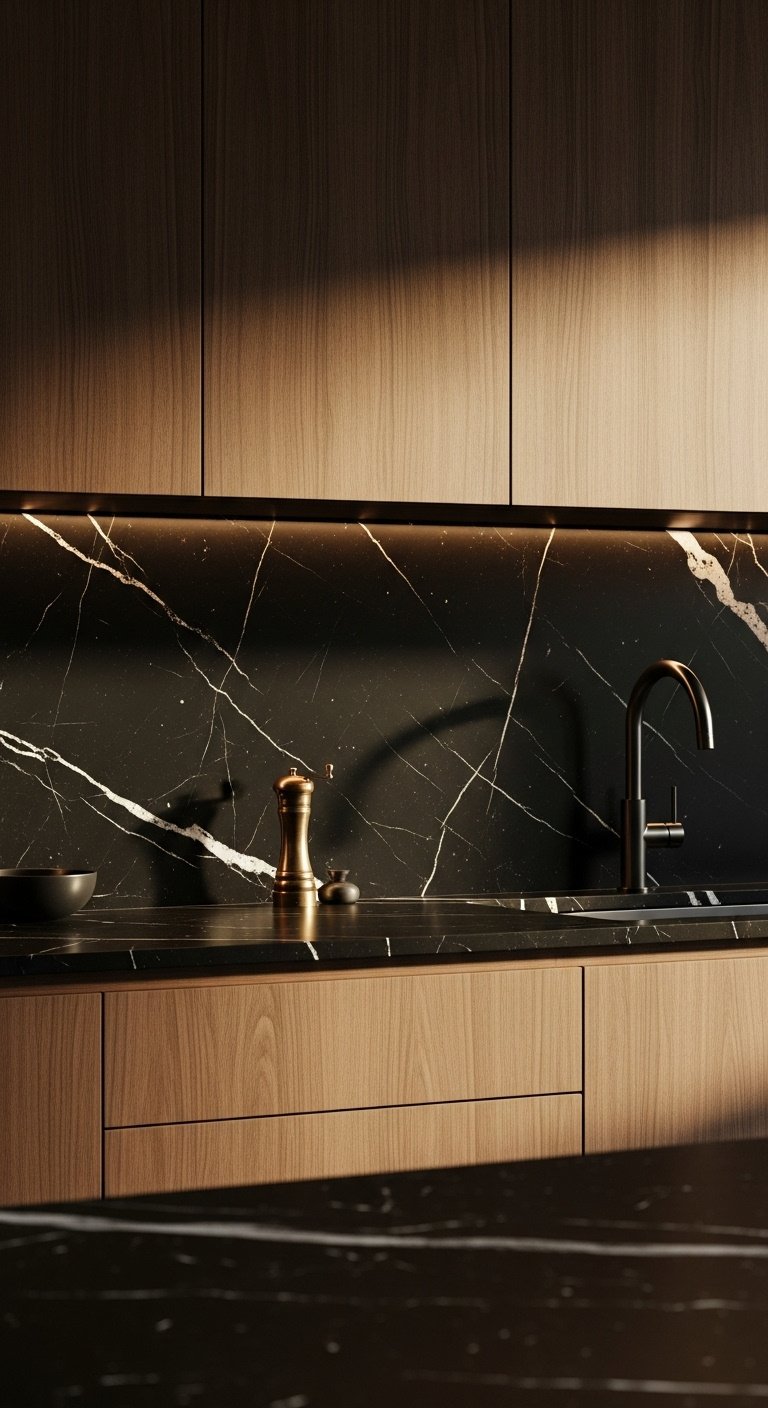
- Materials Needed: Custom-cut slab (e.g., Nero Marquina marble or black quartz), heavy-duty construction adhesive, level, professional installation tools. (Note: This is a job for professionals).
- Step-by-Step Directions:
- Work with a stone fabricator to get precise measurements of your backsplash area.
- Select your slab and approve the template they create.
- Ensure the wall is perfectly flat and prepared for the heavy weight of the slab.
- Professionals will apply adhesive and carefully mount the slab to the wall, ensuring it is perfectly level.
- The seams (if any) and edges will be sealed with color-matched silicone for a flawless finish.
Pro-Tip: To prevent a black slab from making the kitchen feel too dark, ensure you have excellent under-cabinet lighting. LED strips will illuminate the work surface and highlight the beautiful veining in the stone.
Love this moody vibe? Save it to your ‘Modern Home’ board on Pinterest.
3. Natural Harmony: Warm Gray Stone Tile
A warm gray stone tile backsplash provides a soft, natural harmony that beautifully complements the organic grain of brown wood cabinets. Materials like slate or travertine add texture and an earthy, sophisticated feel.
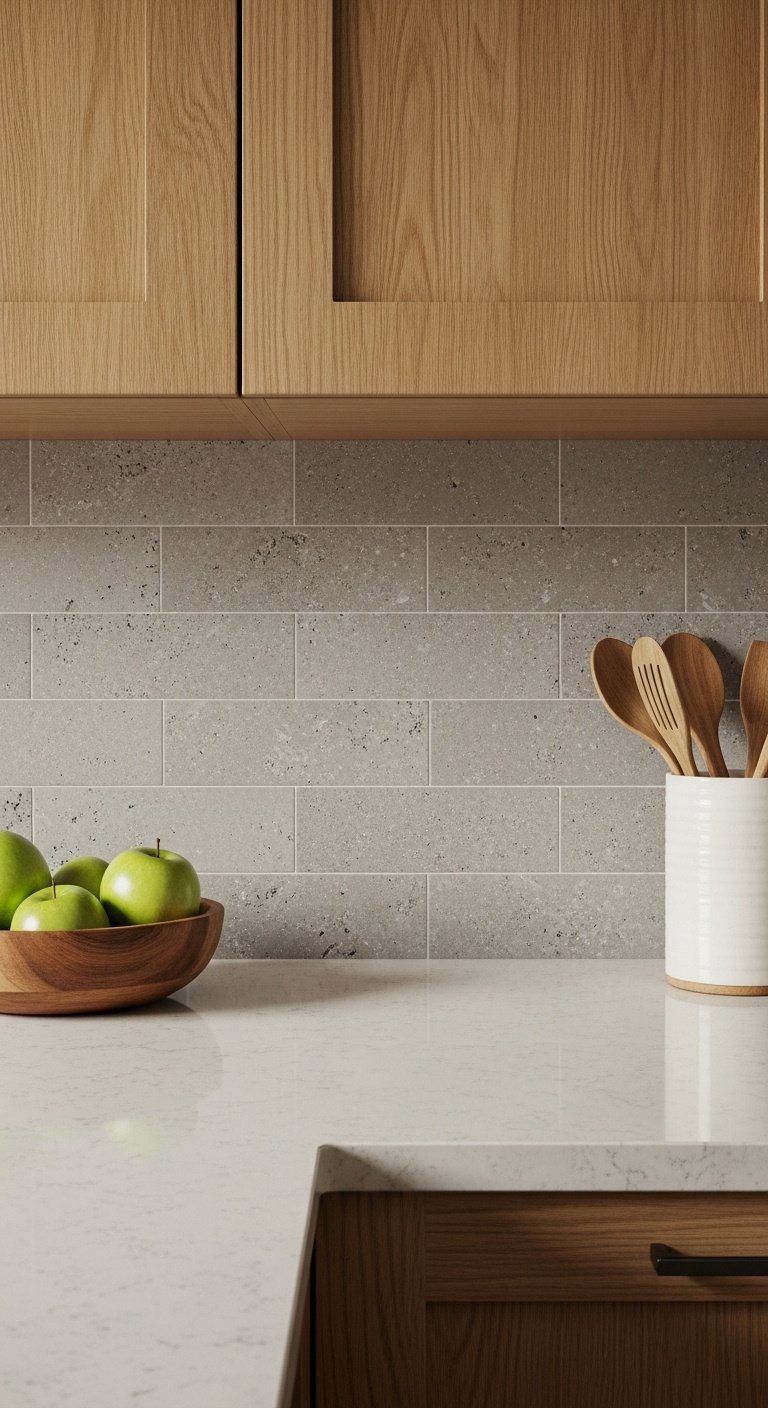
- Materials Needed: Natural stone tiles, appropriate sealer for the stone type, mortar for natural stone, notched trowel, tile spacers, wet saw with a diamond blade, grout.
- Step-by-Step Directions:
- Seal the front, back, and sides of the natural stone tiles before installation to prevent staining from mortar and grout. Let it dry completely.
- Follow steps 1-4 from the subway tile installation, using mortar specifically designed for heavy stone.
- Use a wet saw with a diamond blade suitable for stone to make clean cuts.
- Grout the tiles, being careful to clean the textured surface thoroughly as you go.
- Apply a final coat of sealer to the entire surface (tiles and grout) after the grout has cured to protect against spills.
Pro-Tip: The beauty of natural stone is its variation. Before installing, lay out all your tiles on the floor to arrange them in a pleasing pattern, ensuring that tiles with heavy veining or color differences are distributed evenly.
Bring nature indoors. Pin this harmonious kitchen idea!
4. A Splash of Color: Vibrant Blue Herringbone Tile
A vibrant blue herringbone tile backsplash adds a stunning pop of color and a dynamic pattern that infuses personality into a kitchen with brown cabinets. The classic combination of blue and brown feels both bold and timeless.
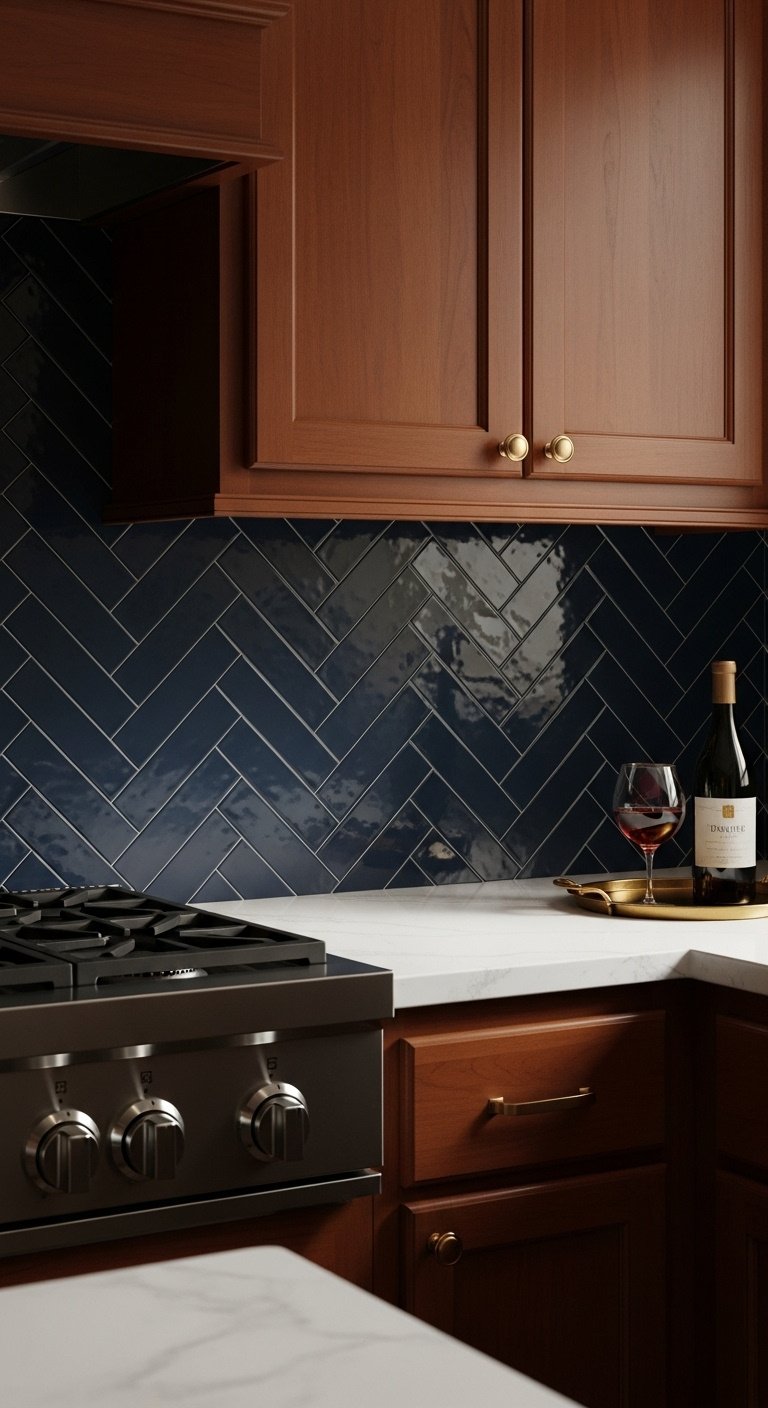
- Materials Needed: Rectangular tiles (e.g., 2×8 inches) in a blue shade, thin-set mortar, notched trowel, tile spacers, wet saw with an angle guide, level, grout.
- Step-by-Step Directions:
- Find the center of your wall and draw a vertical guideline. This is crucial for a symmetrical herringbone pattern.
- Set your first tile at a perfect 45-degree angle to the guideline.
- Work outwards from the center, interlocking the tiles in the classic “V” shape of the herringbone pattern.
- Use the angle guide on your wet saw to make precise 45-degree cuts for the edges of the backsplash.
- Once all tiles are set and the mortar has cured, grout the surface, ensuring all the small joints are filled.
Pro-Tip: A blue and brown combination is historically harmonious. To keep the look sophisticated, pair a deeper navy blue herringbone with dark brown cabinets and brushed brass hardware for a touch of elegance.
Ready for a pop of color? Save this stunning blue backsplash idea.
5. Soft and Subtle: Cozy Beige Mosaic Tile
A cozy beige mosaic tile backsplash offers a warm, subtle texture that creates a seamless and inviting look alongside brown cabinets. This is an excellent choice for achieving a harmonious and traditional feel.
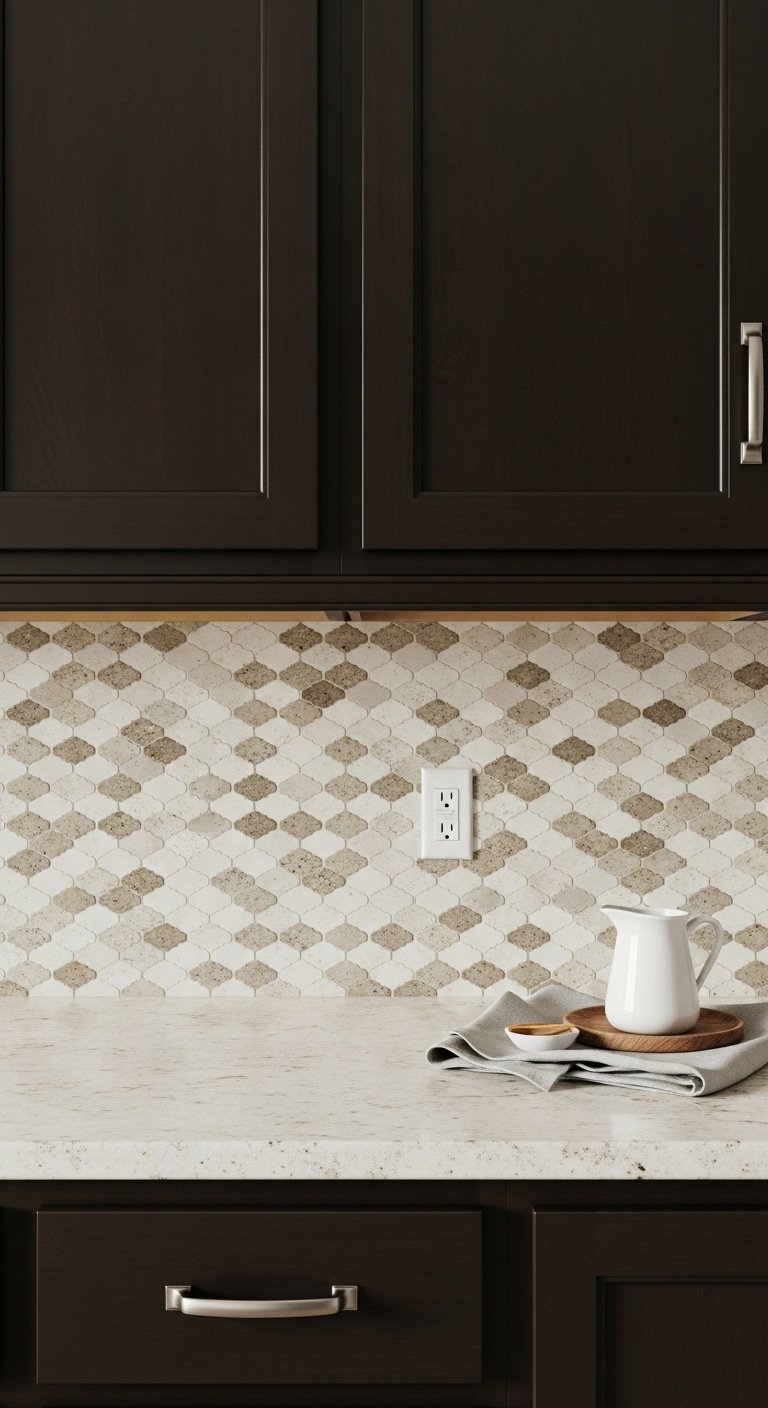
- Materials Needed: Mesh-backed mosaic tile sheets, thin-set mortar, notched trowel, utility knife, grout, grout float, sponge.
- Step-by-Step Directions:
- Apply a smooth, even layer of thin-set mortar to a section of the wall.
- Press the mosaic sheet firmly into the mortar, using a grout float to gently tap it flat and ensure even adhesion.
- Use a utility knife to carefully cut the mesh backing to fit around outlets or at the end of a run.
- Link the sheets together, ensuring the spacing between sheets matches the spacing of the tiles on the sheet to avoid visible seams.
- After the mortar has cured, apply grout over the entire surface, pressing it into all the small gaps.
Pro-Tip: To create a seamless transition, choose a beige mosaic that picks up on the specific undertones of your brown cabinets and the veining in your countertop. A white countertop can act as a beautiful bridge between the two.
Pin this cozy and elegant look for your next kitchen refresh!
6. Rustic Warmth: Earthy Terracotta Tiles
Earthy terracotta tiles provide an unmatched rustic warmth and a connection to natural, handcrafted materials, perfectly enhancing the cozy feel of brown wood cabinets.
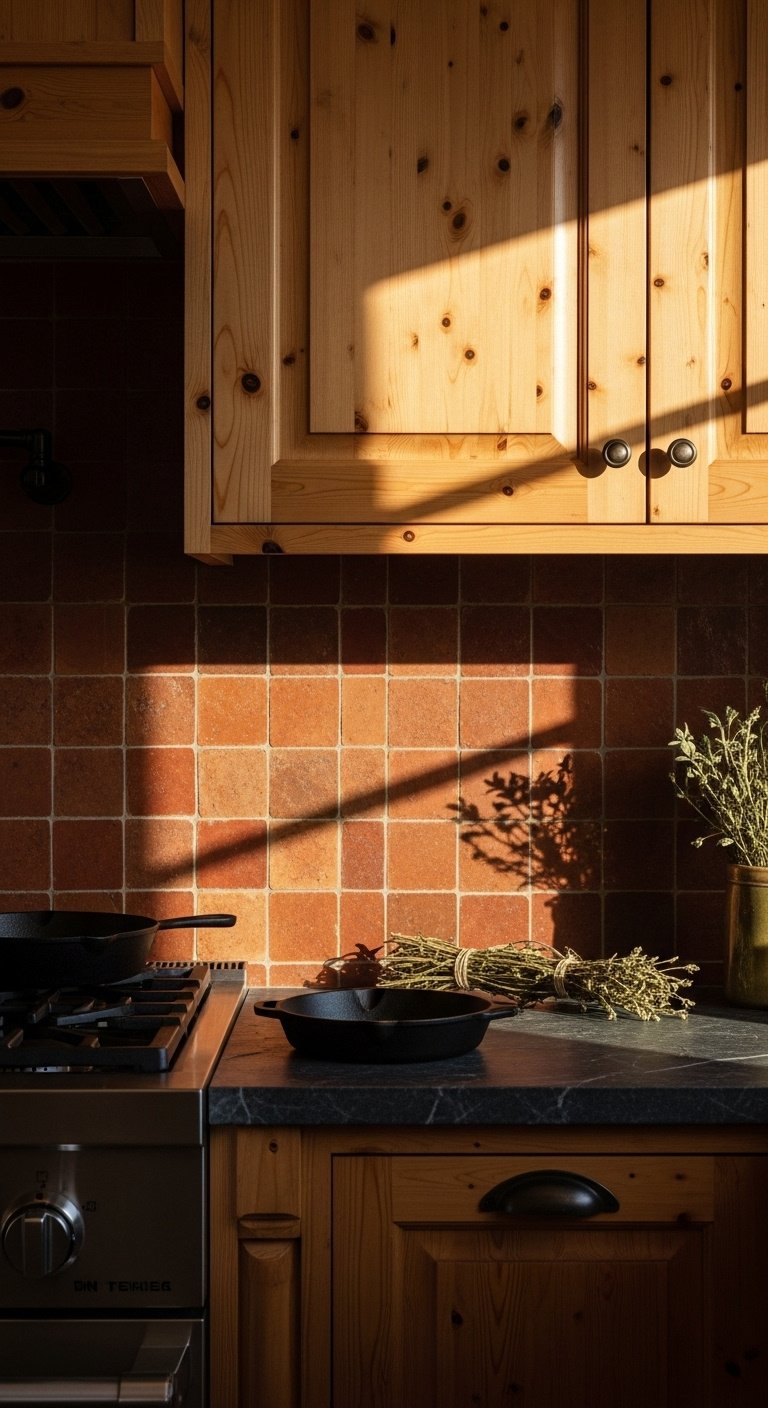
- Materials Needed: Natural terracotta tiles, penetrating sealer, thin-set mortar, wide joint grout, tile spacers.
- Step-by-Step Directions:
- Terracotta is highly porous. It’s essential to seal the tiles on all sides before installation to prevent them from absorbing moisture from the mortar and grout.
- Install using standard tile-setting methods, leaving wider grout lines (around 1/4 inch) to enhance the rustic look.
- Grout the tiles, taking care to clean the surface completely as you go to prevent haze.
- Apply a final top coat of sealer to the entire surface for protection against kitchen splatters.
Pro-Tip: Pair matte terracotta tiles with wrought iron hardware, stone countertops, and open wood shelving to fully commit to the rustic, countryside aesthetic.
Get this warm, rustic look. Save it to your ‘Farmhouse Ideas’ board!
7. Artisanal Touch: Hand-Glazed Zellige Tiles
Hand-glazed Zellige tiles offer a unique, artisanal touch with their beautiful imperfections, color variations, and light-reflecting qualities, adding texture and character to a kitchen with brown cabinets.
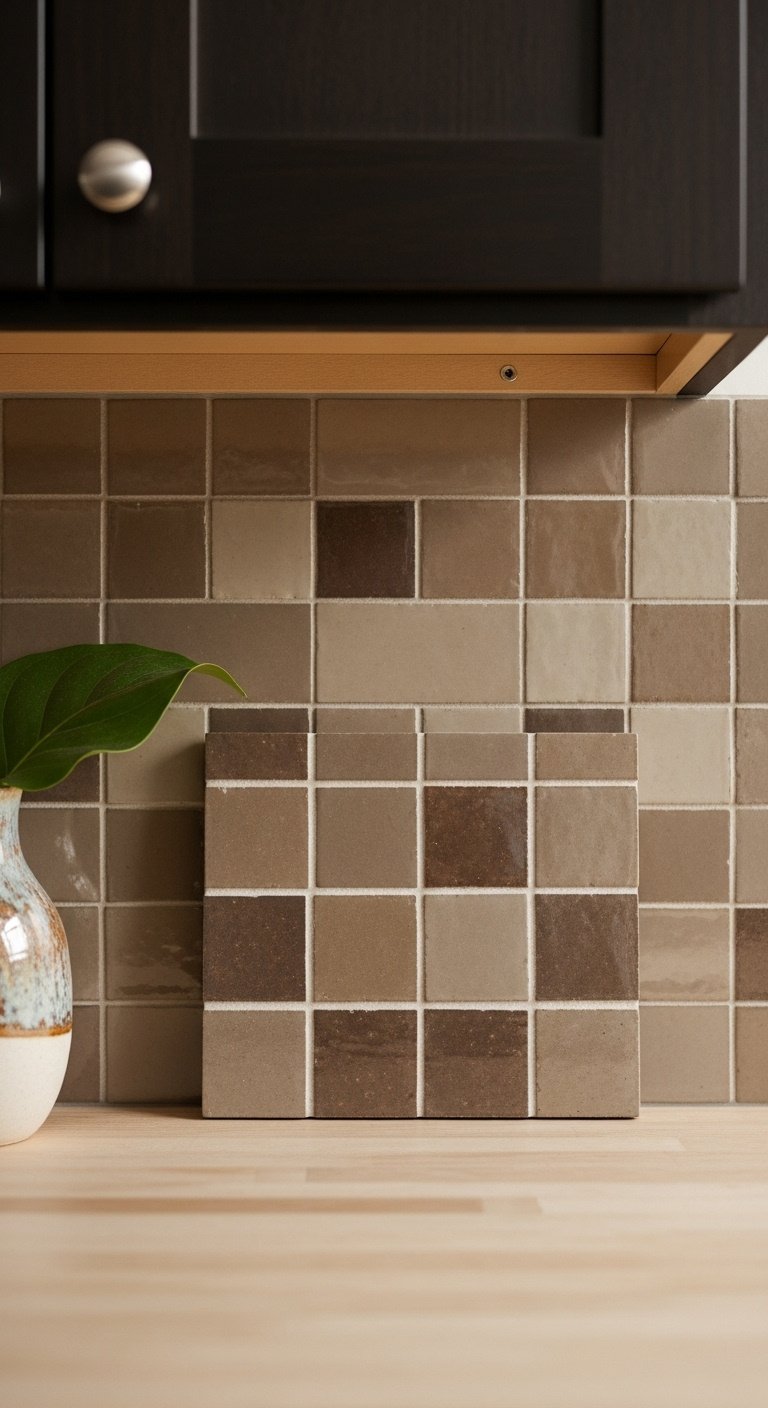
- Materials Needed: Zellige tiles, tile adhesive, level, wet saw, tile nippers. (Note: Grout is often not used for a traditional look).
- Step-by-Step Directions:
- Briefly soak zellige tiles in water for 1-2 minutes before installation to help with adhesion.
- Apply adhesive to the wall.
- Set the tiles very close together, edge-to-edge, without using spacers. The natural imperfections will create the joint.
- Mix tiles from different boxes as you work to ensure a natural blend of color variations across the wall.
- For the most authentic look, skip the grout. If you must grout, use a color that matches the tile and apply it sparingly, cleaning thoroughly.
Pro-Tip: The magic of zellige is in its imperfections and the way it reflects light. Choose a warm brown or taupe zellige tile to subtly enhance wood tones and add a beautiful shimmer to the kitchen.
Add an artisanal touch to your kitchen. Pin this idea!
8. Urban Edge: Industrial Mocha Brick Tile
An industrial mocha brick tile backsplash adds a rugged, textural element and an urban loft character that creates a compelling contrast with the refined finish of brown cabinets.
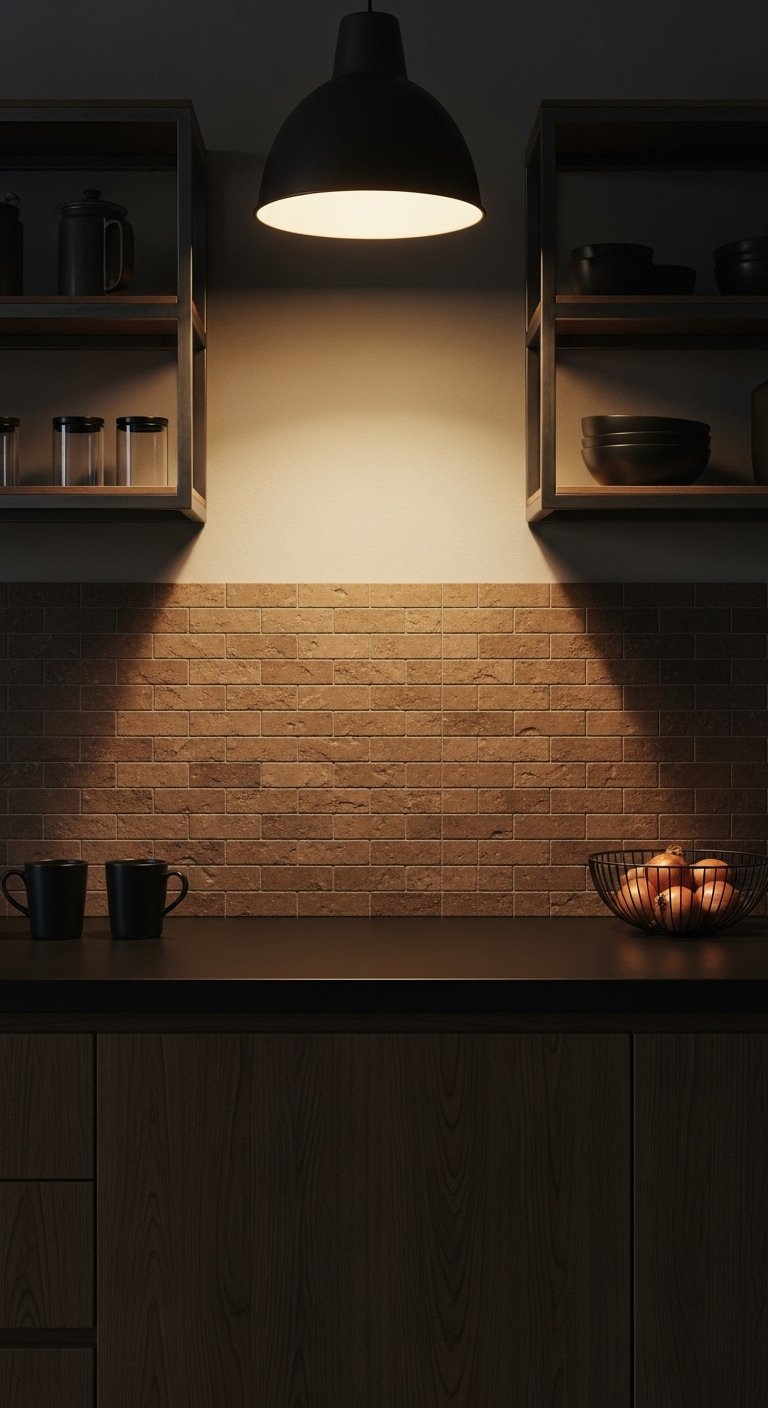
- Materials Needed: Thin brick veneers, construction adhesive or tile mortar, tile spacers (optional, for even grout lines), grout bag, grout, striking tool.
- Step-by-Step Directions:
- Start at the bottom center and work your way out, applying adhesive to the back of each brick veneer and pressing it onto the wall in a classic running bond pattern.
- Use a wet saw with a masonry blade to cut bricks as needed for edges and corners.
- Once the adhesive is cured, use a grout bag to pipe grout into the joints, similar to how a real brick wall is mortared.
- Use a striking tool to shape the grout lines for a professional, clean finish before the grout sets.
Pro-Tip: For an easier, DIY-friendly version, look for high-quality peel-and-stick brick panels. They offer a similar textural look with a much simpler and faster installation process.
Love the industrial look? Pin this brick backsplash idea now!
9. Understated Luxury: Elegant Brown Marble
An elegant brown marble backsplash delivers a timeless, high-end look of understated luxury, using the stone’s natural veining to create a sense of movement and sophistication that harmonizes with brown cabinets.
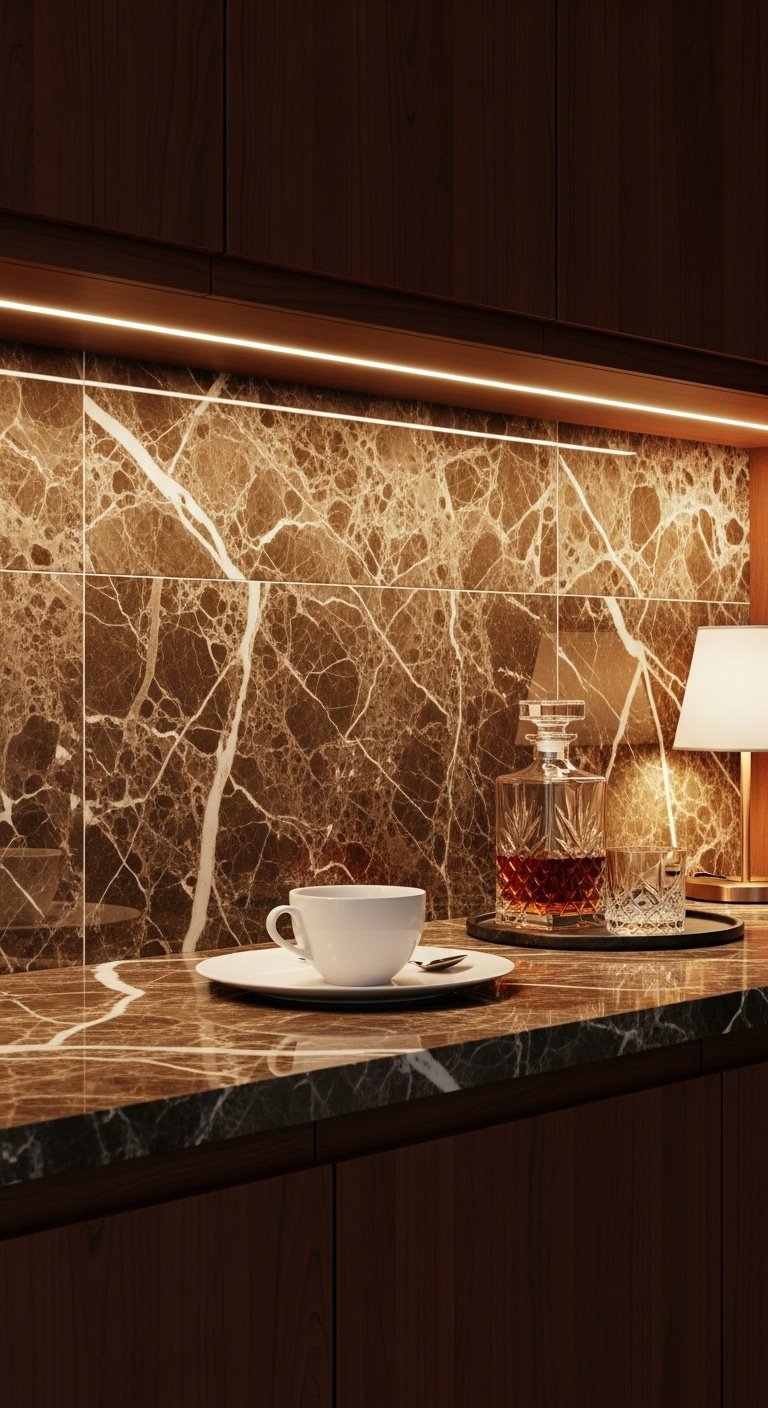
- Materials Needed: Brown marble tiles or slab, marble-safe mortar, wet saw with diamond blade, penetrating sealer for marble, non-sanded grout.
- Step-by-Step Directions:
- Marble is soft and porous. It’s crucial to seal it before and after installation to protect against stains and etching.
- Lay out your tiles first to create a pleasing flow of the veining across the backsplash.
- Install using a white, non-staining mortar specifically designed for light-colored stone to prevent discoloration.
- Grout with a non-sanded grout to avoid scratching the polished surface.
- Plan to re-seal the marble and grout every 6-12 months to maintain its beauty.
Pro-Tip: For the ultimate luxury, consider a full-height slab of brown and gold marble (like Calacatta Gold) to create a seamless, dramatic focal point that feels like a piece of art.
Add a touch of luxury to your kitchen. Save this marble idea!
10. A Touch of Glam: Brown Tile with Metallic Accents
Adding metallic accents to a brown tile backsplash introduces a touch of glam and sparkle, catching the light and adding a layer of sophisticated detail to the kitchen.
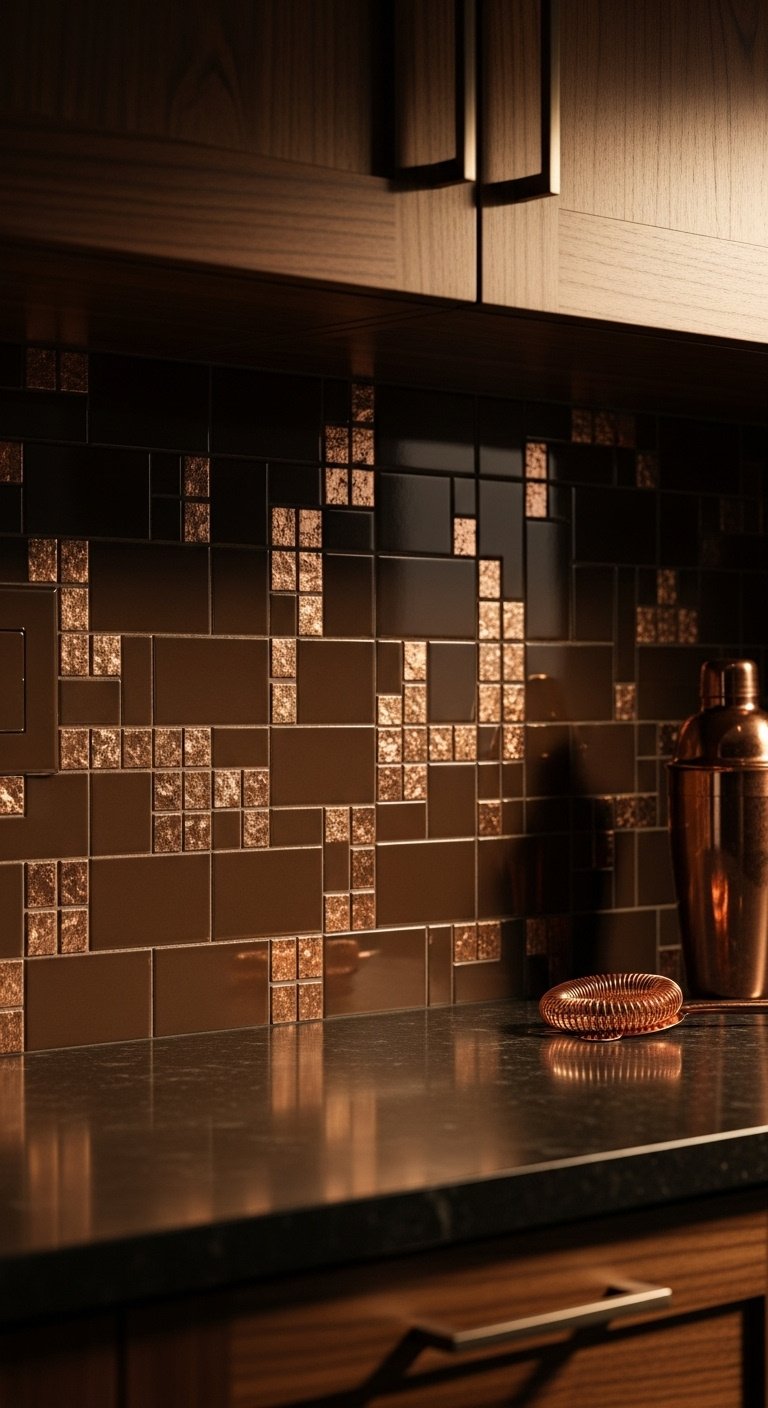
- Materials Needed: Brown field tiles, metallic accent tiles or mosaic sheets, thin-set mortar, notched trowel, non-sanded grout (for metal).
- Step-by-Step Directions:
- Plan your pattern. Decide if you will scatter the metallic tiles randomly, create a border, or use a strip of metallic mosaic as a focal point above the stove.
- Install the main brown tiles first, leaving perfectly sized spaces for your accent pieces.
- Install the metallic accent tiles, ensuring they are flush with the surface of the main tiles.
- When grouting, use a non-sanded grout to avoid scratching the metallic finish. Carefully clean any excess grout off the accents immediately.
Pro-Tip: Match the metallic accent in your backsplash to your cabinet hardware and faucet for a cohesive, professionally designed look. A bronzed sheen on a ceramic tile is a subtle way to achieve this effect.
Pin this glamorous idea for a little kitchen sparkle!
11. Nostalgic Charm: Vintage-Inspired Checkerboard Tile
A vintage-inspired checkerboard tile backsplash provides a bold, graphic pattern that adds nostalgic charm and a dose of personality to a kitchen with brown cabinets.
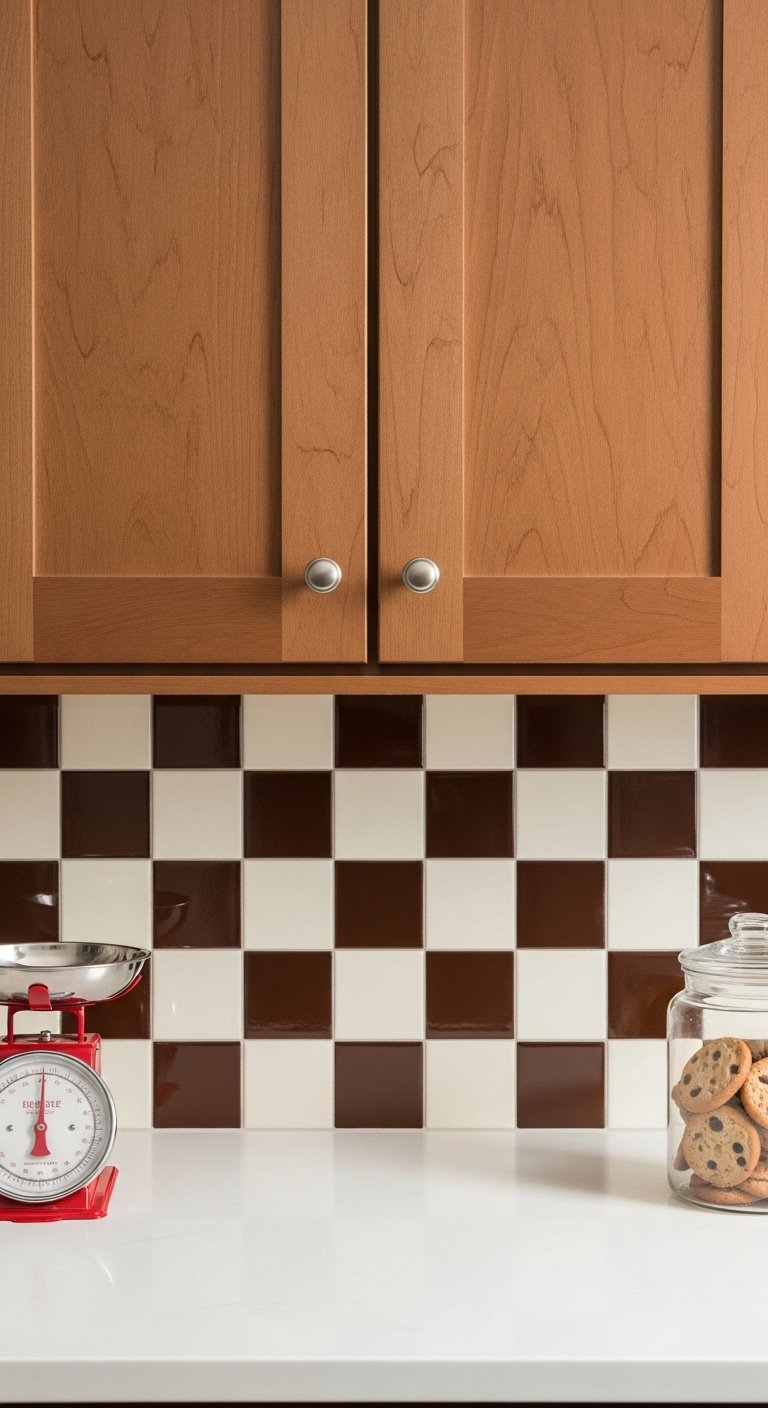
- Materials Needed: Two colors of square tiles (e.g., warm white and chocolate brown), thin-set mortar, tile spacers, level, wet saw, grout.
- Step-by-Step Directions:
- Find the center point of your backsplash area to start your first tile. This ensures a balanced, symmetrical pattern.
- Set your first tile, then alternate colors as you work outwards, using spacers to keep lines perfectly straight.
- Use a level frequently, both horizontally and vertically, to ensure your grid lines are not drifting.
- For a diagonal (harlequin) pattern, start your tiles at a 45-degree angle from the center point.
- Grout the entire surface once the mortar has fully cured.
Pro-Tip: While black and white is classic, a brown and cream checkerboard pattern can feel softer and more cohesive with brown cabinets, offering the same graphic punch with a warmer, more inviting feel.
Add some retro fun to your kitchen! Pin this checkerboard idea.
12. Sleek and Modern: The Vertical Tile Layout
Laying tile in a vertical pattern is a modern twist that draws the eye upward, making the kitchen feel taller and more spacious. This sleek orientation gives even a classic subway tile a contemporary edge.
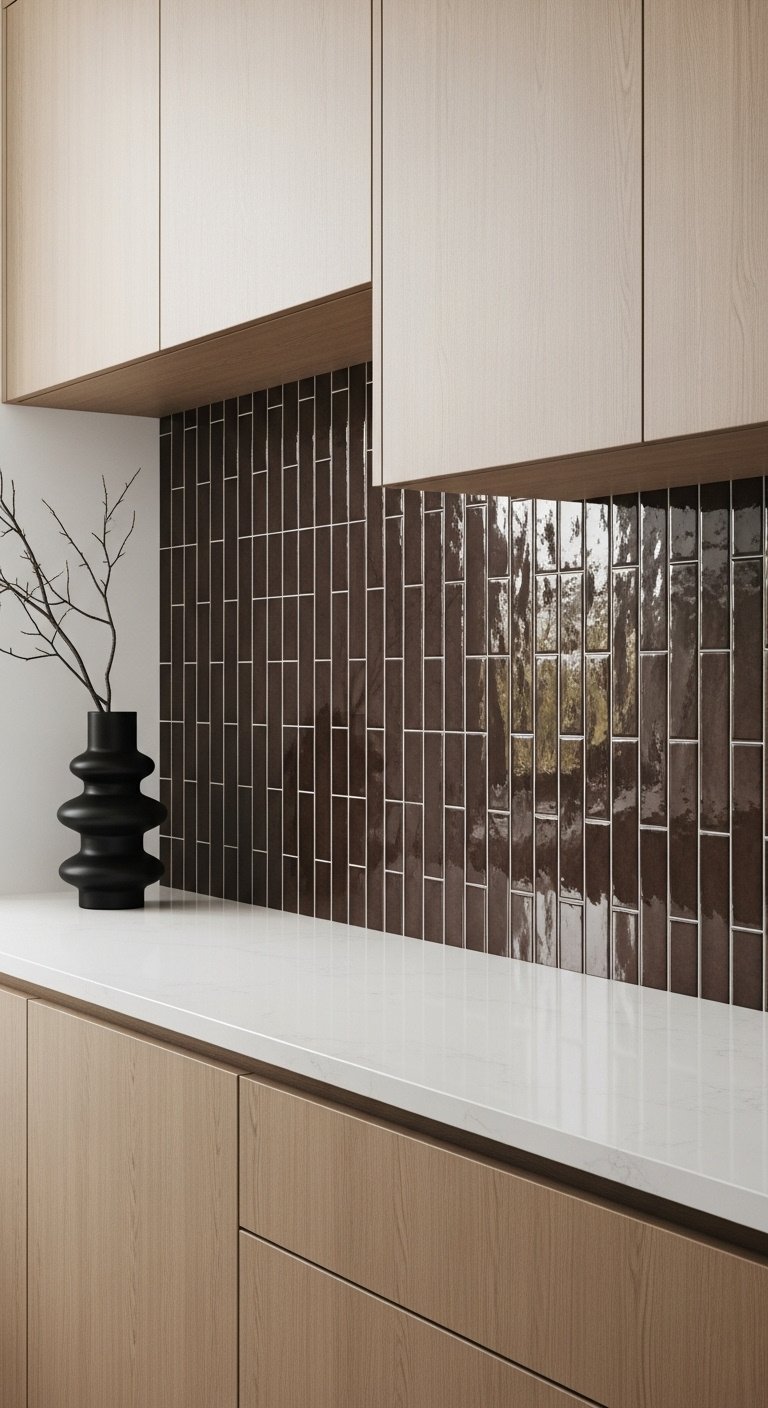
- Materials Needed: Rectangular tiles (e.g., 2×8 or 3×12 subway tiles), thin-set mortar, notched trowel, tile spacers, level, wet saw, grout.
- Step-by-Step Directions:
- Installation is similar to a standard subway tile, but the orientation is key. Start from the countertop and work your way up.
- Set the tiles vertically, side-by-side, in either a stacked or offset pattern. A stacked pattern (where grout lines align perfectly) will give the most modern and graphic look.
- Use a level on every few columns of tile to ensure they are perfectly plumb (vertically straight).
- Grout as usual after the mortar has fully cured.
Pro-Tip: Using a deep brown or chocolate-colored tile in a vertical stacked layout creates a dramatic, sophisticated look that adds depth and enhances the modern feel, especially when paired with flat-panel brown cabinets.
Give your kitchen a modern lift! Pin this vertical tile layout.
13. Handcrafted Beauty: Brown Patterned Encaustic Tile
A brown patterned encaustic tile backsplash acts as a stunning focal point, infusing the kitchen with handcrafted beauty, unique character, and a touch of bohemian flair.
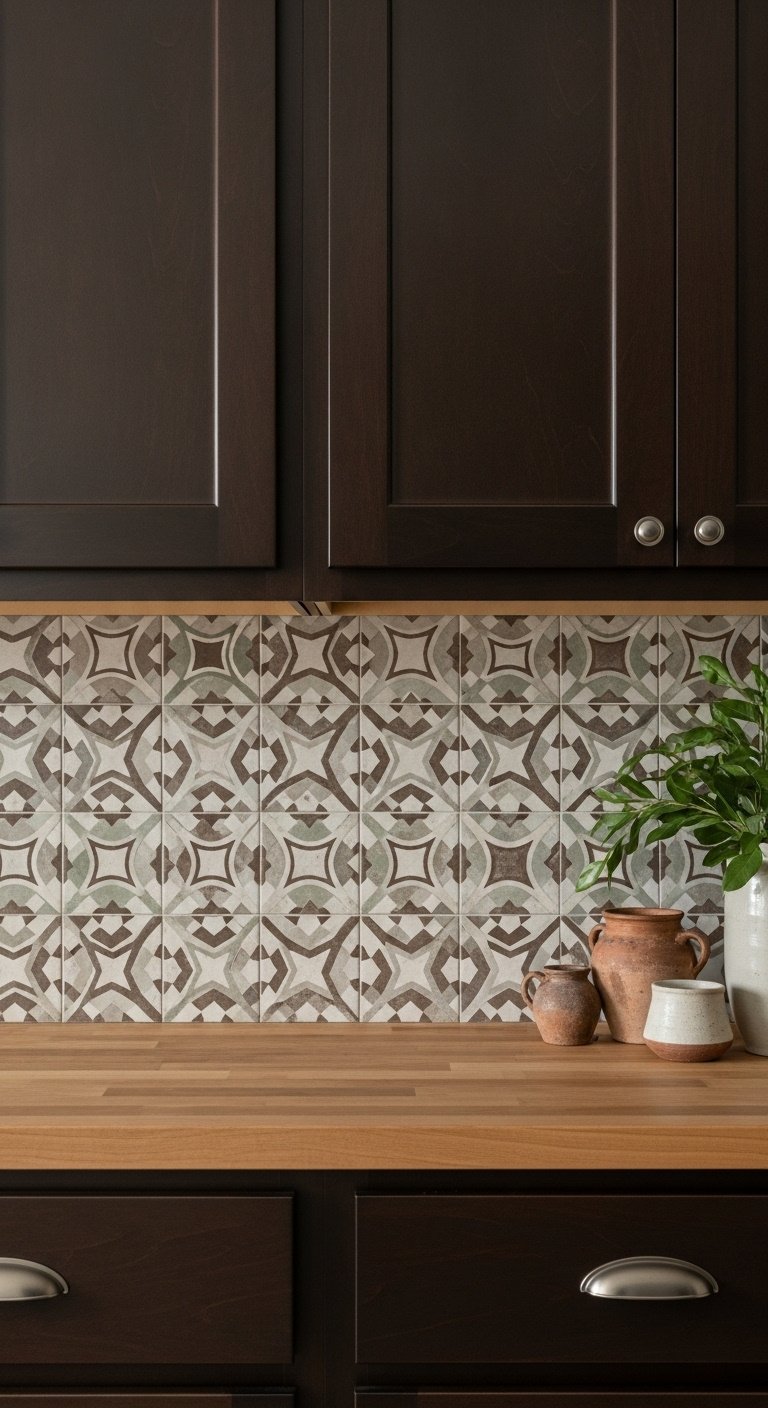
- Materials Needed: Encaustic cement tiles, penetrating sealer, tile adhesive for cement tiles, tile spacers, wet saw, non-sanded grout.
- Step-by-Step Directions:
- Like terracotta, encaustic tiles are porous and MUST be sealed before installation to prevent staining from adhesives and grout.
- Lay out the tiles on the floor first to ensure your pattern flows correctly and to distribute any slight color and pattern variations evenly.
- Install using adhesive, being careful not to get any on the tile face.
- Grout using a non-sanded grout and work in small sections, cleaning immediately to prevent the pigment from staining the porous tile surface.
- Apply a final coat of sealer after the grout has fully cured.
Pro-Tip: When using a bold patterned tile, keep other elements simple. A brown-and-cream patterned backsplash paired with simple brown shaker cabinets and a solid white countertop allows the tile to be the star of the show without overwhelming the space.
Make a statement! Save this patterned tile idea to your inspiration board.
Key Takeaways: Your Quick Guide to Choosing a Backsplash for Brown Cabinets
- Create Contrast: For a modern, bright look, pair brown cabinets with a light backsplash like white, cream, or light gray. For drama, choose black.
- Embrace Harmony: For a warm, cohesive feel, choose backsplash colors that share undertones with your cabinets, such as beige, taupe, or even other shades of brown.
- Texture is Key: Add visual interest to simple cabinets with textured tiles like zellige, natural stone, or brick. If your cabinets have a strong grain, a simpler backsplash may be better.
- Pattern Adds Personality: Use patterns like herringbone, checkerboard, or encaustic tiles to make your backsplash a stunning focal point.
- Don’t Forget Lighting: Good under-cabinet lighting is essential, especially with darker backsplash and cabinet combinations, to keep the space bright and functional.
People Also Ask About Kitchen Backsplashes for Brown Cabinets
What is a popular backsplash to go with brown cabinets?
A classic white subway tile is arguably the most popular backsplash for brown cabinets. It’s timeless, brightens the space, and creates a clean contrast that works with nearly any style, from modern farmhouse to traditional. Other popular choices include soft gray stone for a natural look and beige tiles for warm harmony.
What is the kitchen backsplash trend for 2025?
For 2025, backsplash trends are moving towards natural textures and full-height applications. Hand-glazed tiles like Zellige, which offer color variation and a reflective surface, are very popular. Additionally, seamless slabs of quartz or marble extending from the countertop up the wall are a hallmark of high-end, contemporary design.
Should a backsplash be lighter or darker than brown cabinets?
This depends entirely on the desired effect. A lighter backsplash will create contrast, make the kitchen feel brighter and larger, and highlight the richness of the brown cabinets. A darker backsplash can create a dramatic, moody, and sophisticated look, especially in a well-lit space. There is no right or wrong answer; it’s a matter of personal style.
What countertop color goes with brown cabinets and a backsplash?
Light-colored countertops are the most versatile choice for brown cabinets. A white or light gray quartz or granite countertop acts as a neutral bridge between brown cabinets and almost any backsplash color. It helps to reflect light and keep the kitchen from feeling too heavy, allowing more freedom in your backsplash choice.
Final Thoughts
Updating your kitchen doesn’t have to mean a complete overhaul. Brown cabinets offer a beautiful and versatile foundation, and as you can see, the perfect backsplash is the key to unlocking their full potential. Whether you crave a bright and modern space or a cozy and rustic retreat, the right tile can completely redefine your kitchen’s style.
Use these ideas as a launchpad for your creativity. Your kitchen should be a reflection of you, and now you have the inspiration to create a space you’ll love for years to come.
Which of these backsplash ideas was your favorite? Let me know in the comments below
